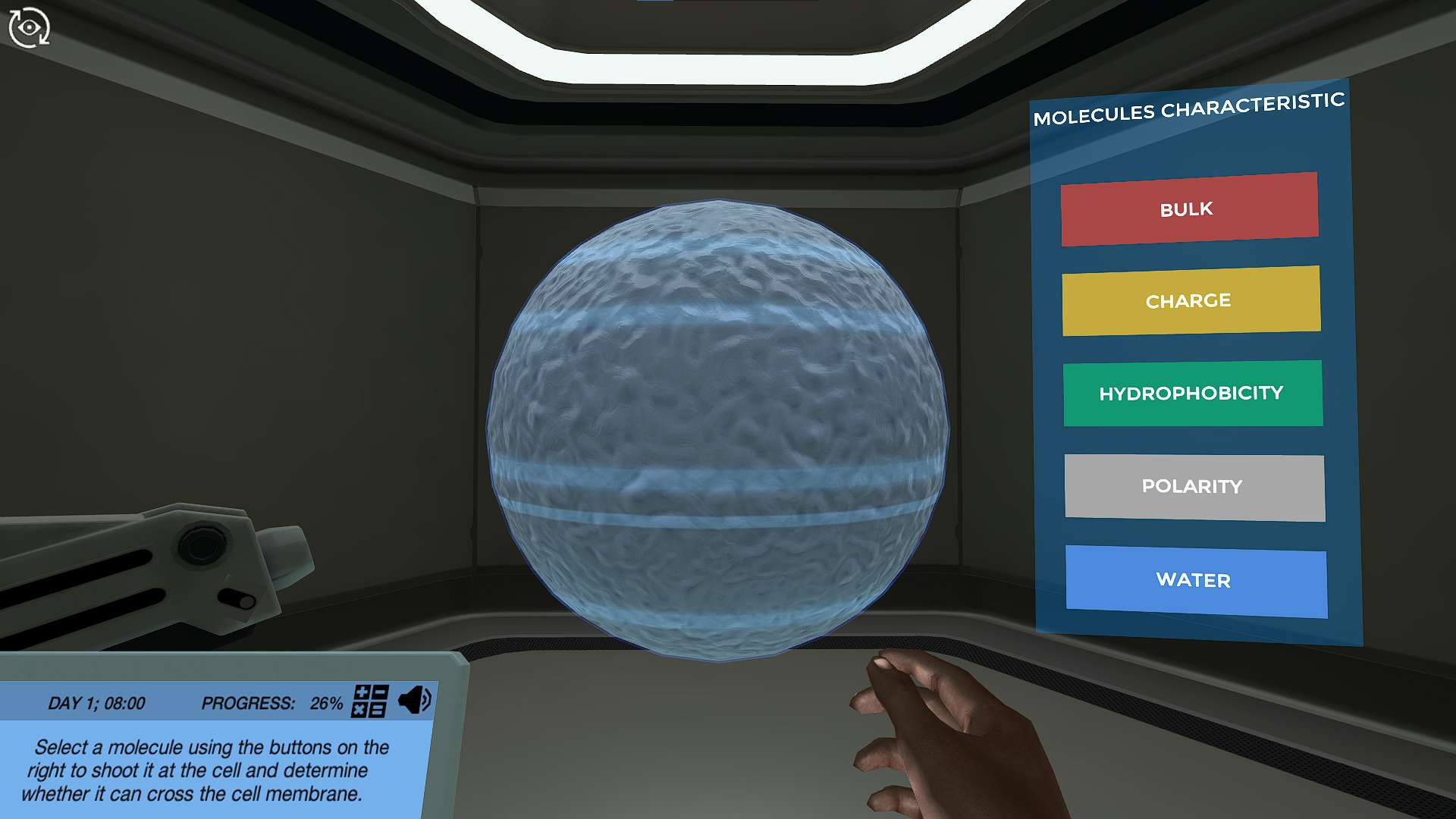Heading 1
Heading 2
Heading 3
Heading 4
Heading 5
Heading 6
Lorem ipsum dolor sit amet, consectetur adipiscing elit, sed do eiusmod tempor incididunt ut labore et dolore magna aliqua. Ut enim ad minim veniam, quis nostrud exercitation ullamco laboris nisi ut aliquip ex ea commodo consequat. Duis aute irure dolor in reprehenderit in voluptate velit esse cillum dolore eu fugiat nulla pariatur.
Block quote
Ordered list
- Item 1
- Item 2
- Item 3
Unordered list
- Item A
- Item B
- Item C
Bold text
Emphasis
Superscript
Subscript
About This Simulation
Discover the structure and function of cell membranes by launching cargo molecules at a virtual cell.
Learning Objectives
- Recognize the relative permeability of lipid bilayers to different classes of molecule
- Compare active and passive transport of molecules
- Identify the 3 modes of active transport and the different classes of ion channel and carrier molecules
About This Simulation
Lab Techniques
Related Standards
- High level content, may support HS-LS2
- Biology 2.5 Membrane permeability
- Biology 2.6 Membrane transport
- Biology 1.4 Membrane transport
Learn More About This Simulation
This short, targeted simulation is adapted from the full-length “Cell Membrane and Transport” simulation.
You have been teleported to a virtual cell! In this simulation you will learn about the molecules that are able to diffuse across the cell membrane and the molecules that require a transporter protein to enter or leave the cell. Here, you can explore the different channels, carriers, and pumps that exist in the membrane and how they ensure that only the right molecules enter under the right conditions.
The main types of transport
Your mission begins by launching molecules at the virtual cell to discover which molecules can travel through the cell membrane alone and which molecules require transporter proteins. You will learn the role of each of the main types of transporter protein: the aquaporin, the carrier protein, and the channel protein.
Transport subtypes and gating mechanisms
Next, you will discover the role of each transporter protein subtypes, and how they work, by launching ions and molecules at the transporter proteins in the cell membrane of our virtual cell. For example, if a molecule needs to be transported by a carrier protein then you will need to identify the transporter proteins on the cell which are a subtype of the carrier protein.
Transport against chemical gradients
Finally, you will identify the transporter proteins that can transport molecules against a chemical gradient and how they work by launching molecules at the virtual cell. By the end of the simulation you will have learned about how ions and molecules can cross the cell membrane by using different types of transporter proteins.
For Science Programs Providing a Learning Advantage
Boost STEM Pass Rates
Boost Learning with Fun
75% of students show high engagement and improved grades with Labster
Discover Simulations That Match Your Syllabus
Easily bolster your learning objectives with relevant, interactive content
Place Students in the Shoes of Real Scientists
Practice a lab procedure or visualize theory through narrative-driven scenarios


FAQs
Find answers to frequently asked questions.
Heading 1
Heading 2
Heading 3
Heading 4
Heading 5
Heading 6
Lorem ipsum dolor sit amet, consectetur adipiscing elit, sed do eiusmod tempor incididunt ut labore et dolore magna aliqua. Ut enim ad minim veniam, quis nostrud exercitation ullamco laboris nisi ut aliquip ex ea commodo consequat. Duis aute irure dolor in reprehenderit in voluptate velit esse cillum dolore eu fugiat nulla pariatur.
Block quote
Ordered list
- Item 1
- Item 2
- Item 3
Unordered list
- Item A
- Item B
- Item C
Bold text
Emphasis
Superscript
Subscript
A Labster virtual lab is an interactive, multimedia assignment that students access right from their computers. Many Labster virtual labs prepare students for success in college by introducing foundational knowledge using multimedia visualizations that make it easier to understand complex concepts. Other Labster virtual labs prepare learners for careers in STEM labs by giving them realistic practice on lab techniques and procedures.
Labster’s virtual lab simulations are created by scientists and designed to maximize engagement and interactivity. Unlike watching a video or reading a textbook, Labster virtual labs are interactive. To make progress, students must think critically and solve a real-world problem. We believe that learning by doing makes STEM stick.
Yes, Labster is compatible with all major LMS (Learning Management Systems) including Blackboard, Canvas, D2L, Moodle, and many others. Students can access Labster like any other assignment. If your institution does not choose an LMS integration, students will log into Labster’s Course Manager once they have an account created. Your institution will decide which is the best access method.
Labster is available for purchase by instructors, faculty, and administrators at education institutions. Purchasing our starter package, Labster Explorer, can be done using a credit card if you are located in the USA, Canada, or Mexico. If you are outside of North America or are choosing a higher plan, please speak with a Labster sales representative. Compare plans.
Labster supports a wide range of STEM courses at the high school, college, and university level across fields in biology, chemistry, physics, and health sciences. You can identify topics for your courses by searching our Content Catalog.







.png?fm=jpg&w=700&h=400)
.png?fm=jpg&w=700&h=400)
.png?fm=jpg&w=700&h=400)





